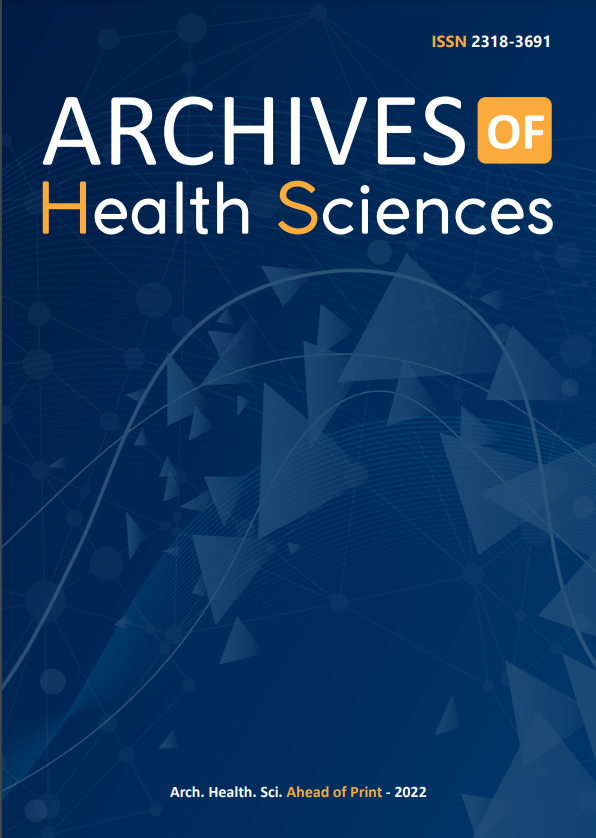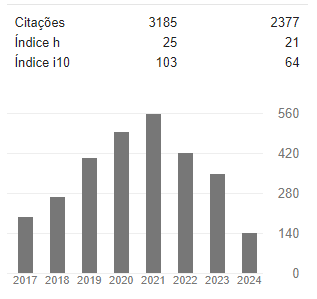Efeitos da equoterapia no equilíbrio, espasticidade e simetria corporal de crianças com paralisia cerebral: revisão sistemática
DOI:
https://doi.org/10.17696/2318-3691.29.1.2022.1975Palavras-chave:
Terapia Assistida por Cavalos; Paralisia Cerebral; Espasticidade Muscular; RevisãoResumo
Introdução: A Paralisia Cerebral (P.C.) caracteriza-se por um conjunto de desordens de tônus, posturais e de movimento não progressivas, decorrentes de lesões cerebrais que ocorrem no cérebro ainda em desenvolvimento no período fetal, perinatal ou pós-natal. Uma das abordagens terapêuticas para os indivíduos com P.C. é a terapia assistida por cavalos, comumente conhecida como Equoterapia. Objetivo: Analisar os efeitos terapêuticos da Equoterapia no equilíbrio postural, espasticidade e simetria corporal de crianças com P.C. Métodos: Trata-se de um estudo de revisão sistemática, conduzido conforme a metodologia PRISMA. Artigos classificados como ensaios clínicos controlados foram pesquisados nas bases de dados PEDro, PubMed, LILACS, MEDLINE e CENTRAL. Os artigos foram avaliados quanto à sua qualidade metodológica através da escala PEDro. Resultados: Oito artigos foram incluídos para análise com amostra total de 310 crianças com paralisia cerebral que foram submetidas ou não a um protocolo de Equoterapia. O escore médio geral, resultante da avaliação da qualidade dos estudos, foi de 5,75. Todos os oito estudos analisados apresentaram resultados benéficos advindos das sessões terapêuticas de Equoterapia no tratamento das crianças com paralisia cerebral, para pelo menos uma das variáveis avaliadas. Conclusão: A Equoterapia pode resultar em efeitos positivos e relevantes na melhoria do equilíbrio postural, simetria corporal e redução na espasticidade de crianças com paralisia cerebral sendo, portanto, considerada uma abordagem eficaz no tratamento destes pacientes.Referências
Fonseca LS, Reis AATC, Sousa AZA, Diniz ACC. Paralisia cerebral – conceito, etiologia, classificação e tratamento. In: Burns DAR, Júnior DC, Silva LR, Borges WG, et al. Tratado de pediatria. 4. ed. Barueri: Manole; 2017.p. 1346-1347.
Shevell M. Cerebral palsy to cerebral palsy spectrum disorder: Time for a name change? Neurology. 2018; 92(5):1-3. doi: 10.1212/WNL.0000000000006747
Afzali M, Etemad K, Kazemi A, Rabiei R. Cerebral palsy information system with an approach to information architecture: a systematic review. BMJ Health Care Inform. 2019;26(1):e100055. doi: 10.1136/bmjhci-2019-100055
McGibbon NH, Benda W, Duncan BR, Silkwood-Sherer D. Immediate and long-term effects of hippotherapy on symmetry of adductor muscle activity and functional ability in children with spastic cerebral palsy. Arch Phys Med Rehabil. 2009;90(6):966-74. doi: 10.1016/j.apmr.2009.01.011
Rose J. Neuromuscular correlates of motor function in cerebral palsy: towards targeted treatment. Dev Med Child Neurol. 2019;61(1):7-8. doi: 10.1111/dmcn.14062
Lucena-Antón D, Rosety-Rodríguez I, Moral-Munoz JA. Effects of a hippotherapy intervention on muscle spasticity in children with cerebral palsy: A randomized controlled trial. Complement Ther Clin Pract. 2018;31:188-92. doi: 10.1016/j.ctcp.2018.02.013
Hemachithra, C, Meena, N, Ramanathan, R, Felix, AJW. Immediate effect of horse riding simulator on adductor spasticity in children with cerebral palsy: A randomized controlled trial. Physiother Res Int. 2020;25(1):e1809. doi: 10.1002/pri.1809
Moraes AG, Copetti F, Angelo VR, Chiavoloni LL, David AC. The effects of hippotherapy on postural balance and functional ability in children with cerebral palsy. J phys ther sci. 2016;28(8):2220-2226. doi:10.1589/jpts.28.2220
Rosan L, Braccialli LMP, Araújo RCT. Contribuição da equoterapia para a participação e qualidade de vida do praticante com paralisia cerebral em diferentes contextos. Revista Diálogos e Perspectivas em Educação Especial. Rev Diálogos Perspect Educ Espec. 2016;3(1):48-61. doi: 10.36311/2358-8845.2016.v3n1.06.p48
Lauruschkus K, Hallström I, Westbom L, Tornberg Å, Nordmark E. Participation in physical activities for children with cerebral palsy: feasibility and effectiveness of physical activity on prescription. Arch Physiother. 2017;7(1):1-12. doi: 10.1186/s40945-017-0041-9
Mello EMCL, Silva GLS, Trigueiro RZ, Oliveira, ALS. A influência da equoterapia no desenvolvimento global na paralisia cerebral: revisão da literatura. Cad Pós-Grad Distúrb Desenvolv. 2018;18(2):12-27. doi: 10.5935/cadernosdisturbios.v18n2p12-27
Martín-Valero R, Vega-Ballón J, Perez-Cabezas V. Benefits of hippotherapy in children with cerebral palsy: a narrative review. Eur J Paediatr Neurol. 2018;22(6):1150-60. doi:10.1016/j.ejpn.2018.07.002
Champagne D, Corriveau H, Dugas C. Effect of hippotherapy on motor proficiency and function in children with cerebral palsy who walk. Phys Occup Ther Pediatr. 2017;37(1):51-63. doi:10.3109/01942638.2015.1129386
Liberati A, Altman DG, Tetzlaff J, Mulrow C, Gøtzsche PC, Ioannidis JPA, et al. The PRISMA statement for reporting systematic reviews and meta-analyses of studies that evaluate health care interventions: explanation and elaboration. PLoS Med. 2009;6(7):e1000100. doi: 10.1371/journal.pmed.1000100
Moseley AM, Elkins MR, Van der Wees PJ, Pinheiro MB. Using research to guide practice: the Physiotherapy Evidence Database (PEDro). Braz J Phys Ther. 2020;24(5):384-91. doi: 10.1016/j.bjpt.2019.11.002
Moseley AM, Rahman P, Wells GA, Zadro JR, Sherrington C, Toupin-April K, et al. Agreement between the Cochrane risk of bias tool and Physiotherapy Evidence Database (PEDro) scale: a meta-epidemiological study of randomized controlled trials of physical therapy interventions. PLoS One. 2019;14(9):e0222770. doi: 10.1371/journal.pone.0222770
Van Peppen RPS, Kwakkel G, Wood-Dauphinee S, Hendriks HJM, Van der Wees PJ, Dekker J. The impact of physical therapy on functional outcomes after stroke what’s the evidence. Clin Rehabil. 2004;18(8):833-62. doi: 10.1191/0269215504cr843oa
Benda W, McGibbon NH, Grant KL. Improvements in muscle symmetry in children with cerebral palsy after equine-assisted therapy (hippotherapy). J Altern Complement Med. 2003;9(6):817-825. doi: 10.1089/107555303771952163
Kang H, Jung J, Yu J. Effects of hippotherapy on the sitting balance of children with cerebral palsy: a randomized control trial. J phys ther sci. 2012;24(9):833-6. doi: 10.1589/jpts.24.833
Kwon JY, Chang HJ, Yi SH, Lee JY, Shin HY, Kim YH. Effect of hippotherapy on gross motor function in children with cerebral palsy: a randomized controlled trial. J Altern Complement Med. 2015;21(1):15-21. doi: 10.1089/acm.2014.0021
Matusiak-Wieczorek E, Małachowska-Sobieska M, Synder M. Influence of hippotherapy on body balance in the sitting position among children with cerebral palsy. Ortop Traumatol Rehabil. 2016;18(2):165-75. doi: 10.5604/15093492.1205024
Sik BY, Cekmece C, Dursun N, Dursun E, Balikci E, Altunkanat Z, et al. Is hyppotherapy beneficial for rehabilitation of children with cerebral palsy?. Turkiye Klinikleri J Med Sci. 2012;32(3):601-8. doi: 10.5336/medsci.2011-22465
Silkwood-Sherer DJ, McGibbon NH. Can hippotherapy make a difference in the quality of life of children with cerebral palsy? A pragmatic study. Physiother Theory Pract. 2022;38(3):390-400. doi: 10.1080/09593985.2020.1759167
Physiotherapy Evidence Database - PEDro [homepage na Internet]. 2022 [acesso em 2020 Jul 6]. Disponível em: http://www.pedro.org.au
Wimalasundera N, Stevenson VL. Cerebral palsy. Pract Neurol. 2016;16(3):184-94. doi: 10.1136/practneurol-2015-001184
Pham R, Mol BW, Gecz J, MacLennan AH, MacLennan SC, Corbett MA, et al. Definition and diagnosis of cerebral palsy in genetic studies: a systematic review. Dev Med Child Neurol. 2020;62(9):1024-30. doi: 10.1111/dmcn.14585
Wood WH, Fields BE. Hippotherapy: a systematic mapping review of peer-reviewed research, 1980 to 2018. Disabil Rehabil. 2021;43(10):1463-87. doi: 10.1080/09638288.2019.1653997
Bertoti DB. Effect of therapeutic horseback riding on posture in children with cerebral palsy. Phys Ther. 1988;68(10):1505-12.
Kwon JY, Chang HJ, Lee JY, Ha Y, Lee PK, Kim YH. Effects of hippotherapy on gait parameters in children with bilateral spastic cerebral palsy. Arch Phys Med Rehabil. 2011;92(5):774-9. doi: 10.1016/j.apmr.2010.11.031
Shurtleff TL, Standeven JW, Engsberg JR. Changes in dynamic trunk/head stability and functional reach after hippotherapy. Arch Phys Med Rehabil. 2009;90(7):1185-95. doi: 10.1016/j.apmr.2009.01.026
Alemdaroğlu E, Yanıkoğlu İ, Öken Ö, Uçan H, Ersöz M, Köseoğlu BF, et al. Horseback riding therapy in addition to conventional rehabilitation program decreases spasticity in children with cerebral palsy: a small sample study. Complement Ther Clin Pract. 2016;23:26-9. doi: 10.1016/j.ctcp.2016.02.002
Downloads
Publicado
Edição
Seção
Licença
Copyright (c) 2022 Archives of Health Sciences

Este trabalho está licenciado sob uma licença Creative Commons Attribution-NonCommercial-NoDerivatives 4.0 International License.











